|
 |
|
|
|
 |
|
 |
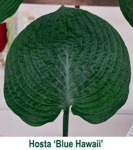 The base or primary leaf color is
defined as the color that occupies at least 60% of the surface
area of the plant. Secondary colors, usually involved with
variegation, are
those colors that occupy 40% or less of the surface area. The base or primary leaf color is
defined as the color that occupies at least 60% of the surface
area of the plant. Secondary colors, usually involved with
variegation, are
those colors that occupy 40% or less of the surface area.
In the landscape, we are
concerned with visible light which is that part of the spectrum
of light waves that is reflected back to our eyes from a plant.
In design, we use these colors to form combinations that are
pleasing to the average human's perceptions.
Basically, the color in hostas is
due to the amount of chlorophyll (green), carotene (yellow) or
waxy bloom (blue) in the leaf. The complete absence of
chlorophyll results in white being reflected from the leaf.
Of course, some plants have only
one color covering 100% of the leaf surface. These are often
called monochrome colors. A distinctive secondary is not present
so these are considered non-variegated plants.
Colors of hosta leaves can change
for a variety of reasons. These include concepts such as
stability, sporting, surface effects and seasonal color changes.
The American Hosta Society
recommends using the
Royal Horticultural Society Colour Chart for accurate hosta leaf
color determination.
Typical base leaf colors in
hostas would include:
|
|
 |
 |
|
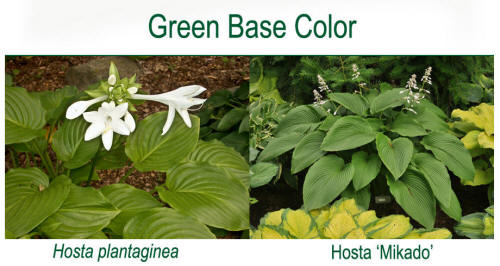 |
In the wilds of
Japan, Korea and China, hosta leaves are various
shades of green. With that said, it must be understood that there
are many different variations of this color found in cultivated
hosta plants. According to the
AHS cultivar
registration form,
hostas should be described as light green, medium green or dark
green.
Of course, these are the "official" color
categories but nursery catalogs and gardeners may use other terms to
describe their particular shade of green. For example, chartreuse is
often used to describe the color of cultivars such as H. 'Sum and
Substance' and H. 'Chartreuse Wriggles'. A few hostas with very,
very dark green leaves may be described as "black" at times.
|
|
|
|
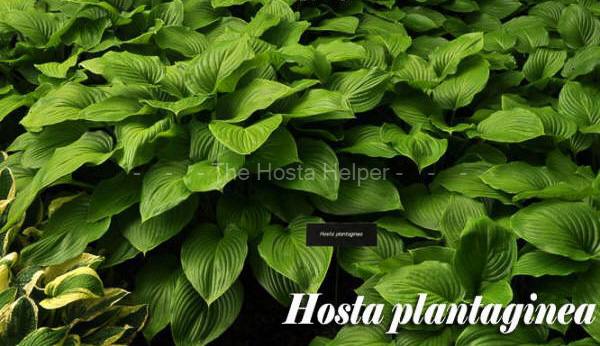 |
|
 |
|
 |
|
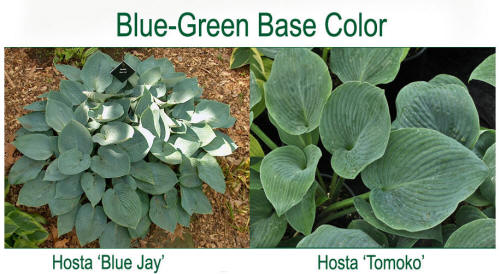 |
Throughout the
hosta world plants like H.
sieboldiana 'Elegans' are almost universally referred to as
"blue" hostas. However, such plants are all technically, blue-green
in color. When registering a new hosta, The American Hosta Society
recommends that you use terms such as slightly blue-green, medium
blue-green and intensely blue-green to identify this leaf
coloration. Some references or catalogs may talk about blue,
blue-green, gray and gray-green to describe these plants.
As mentioned before, all the species hostas are
green. The difference here is that some hostas have developed a waxy
coating over the green which reflects blue light. Thus, we see them
as blue-green. If you rub the leaf of a blue hosta between your
fingers and remove the wax, it will quickly show the green below.
The wax on the leaf surface is at its thickest
and best in the cool of the spring. As the summer progresses, the
heat of the sun and pounding rain, will cause the wax to wear off.
Plus, hostas appear to produce less wax as the summer advances. So,
by autumn, many "blue" hostas become green hostas. This doesn't hurt
the plant but, if you wanted the blue color to work as a complement
to nearby yellow plants, you will lose that effect late in the year.
Hostas that develop a very thin covering of wax
may lose it very early in the season. These plants end up spending
most of the summer as green hostas and may be classified as either
base color category (blue-green or green) depending on the reference
or catalog.
Mr. PGC Comment: The blue-green cultivar
H. sieboldiana 'Elegans' was developed in 1905 and has
since become one of the all-time classics in the hosta world. At a
recent meeting, I heard the hosta Registrar mention that around 400
new cultivars had been registered the previous year. Of those, over
half had 'Elegans' in their background. There are a huge number of large
blue hostas out there, folks!
|
|
|
|
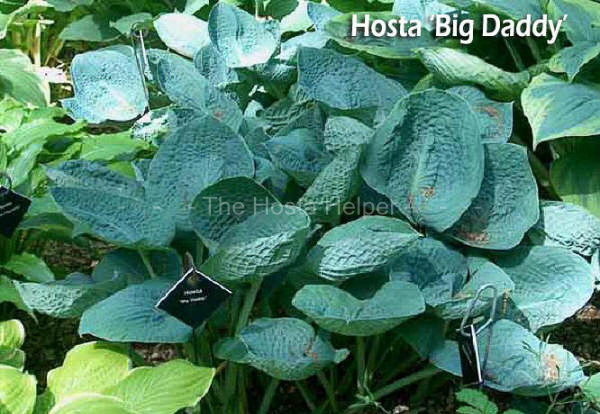 |
|
 |
 |
|
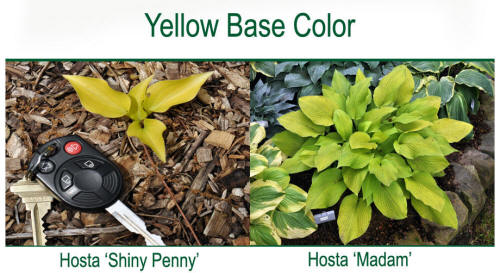 |
Yellow Leaves -
How many times have you heard a hosta referred to as being
"gold" in color? Well, as with blue, that is not an official
designation. If you look at a color wheel, you will not find
gold but you will find yellow as a primary color and that is the
proper descriptive term. The registration form recommends the
use of greenish-yellow, pale yellow, yellow and golden yellow to
describe new hostas.
Yellow color in hosta leaves is the result of a
mutation called an inhibitor gene which causes the plant to produce
a very low level of chlorophyll in certain chloroplasts. Depending
on the amount of inhibition that takes place, the leaf color will
vary from chartreuse to a very dark, rich yellow or "gold".
|
|
|
|
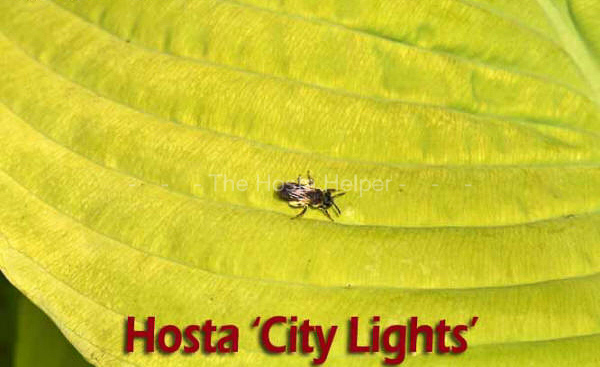 |
|
 |
|
 |
|
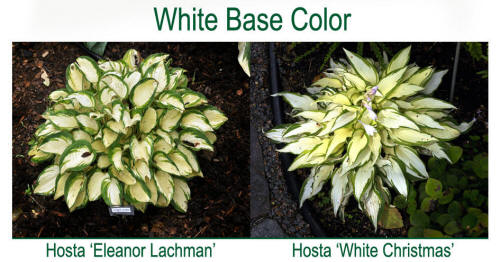 |
White Leaves -
Although most gardeners might not think of it, white can also be
a base color for hostas (although NOT included on the AHS
registration form). A hosta may have 60% of its leaf surface
white but, of course, a plant cannot be totally white in color.
 Occasionally,
a seedling will emerge that is entirely white but once the
energy from the seed is spent, it will die. Without the green
chlorophyll molecule, such plants will not be able to carry out
photosynthesis and feed themselves. Occasionally,
a seedling will emerge that is entirely white but once the
energy from the seed is spent, it will die. Without the green
chlorophyll molecule, such plants will not be able to carry out
photosynthesis and feed themselves.
However, certain variegated plants come close
to being totally white but still have enough green chlorophyll so
they are capable of supporting themselves. Such plants will
generally have very thin leaf substance and will grow more slowly
than their fully green species forms. They are also sometimes
difficult to site properly in the garden. If they are exposed to too
much sun, the thin leaves will lose moisture rapidly and "burn"
easily. Finally, there is some evidence that slugs prefer to chew on
leaves with thin substance so many of these types of hostas look
pretty ratty by the end of the summer in typical home gardens.
The official descriptive terms for these types
of hostas would include greenish white, creamy white and pure white.
Mr. PGC Comment: The problem is that
some of these mostly white hostas are SPECTACULAR looking in the
early spring before the heat of the summer and slugs do their thing
on them.
|
|
 |
|
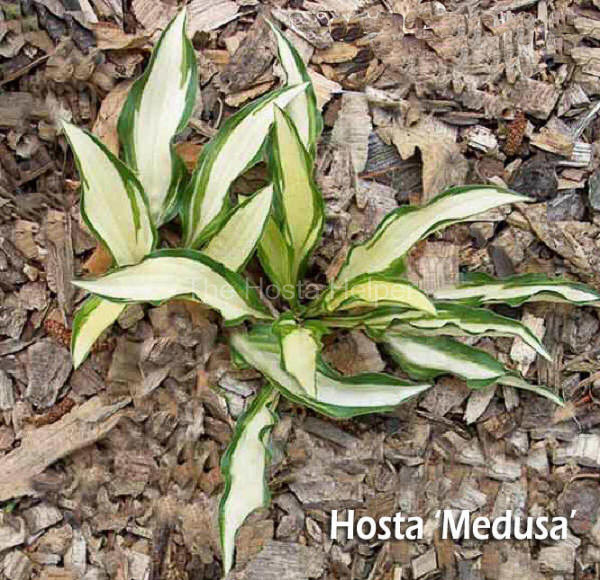 |
|
 |
|
 |
|
|
|



